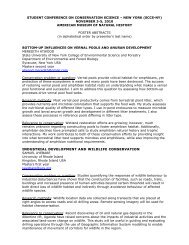Make Your Own Liaoning Diorama - American Museum of Natural ...
Make Your Own Liaoning Diorama - American Museum of Natural ...
Make Your Own Liaoning Diorama - American Museum of Natural ...
- No tags were found...
Create successful ePaper yourself
Turn your PDF publications into a flip-book with our unique Google optimized e-Paper software.
www.amnh.orgActivity: <strong>Make</strong> <strong>Your</strong> <strong>Own</strong> <strong>Liaoning</strong> <strong>Diorama</strong>IntroductionStudents will create their own diorama or mural <strong>of</strong> the <strong>Liaoning</strong> forest and use itto draw conclusions about how that ecosystem functioned.ObjectivesStudents will:• re-create the 130-million-year-old <strong>Liaoning</strong> forest.• understand that some dinosaurs lived in forest settings similar to today’s forestsalongside many other types <strong>of</strong> animals. (Younger students)• draw conclusions about climate, animal behavior, and predator/preyrelationships. (Older students)Time FrameApproximately two periods (40 minutes each)Materials• <strong>Liaoning</strong> Forest mural (grades K-2) or <strong>Liaoning</strong> Forest background andcutouts (grades 3-8), duplicated for each student• Art materials such as scissors, glue, cardboard paper, and colored pencilsor crayons• Shoebox for each student (grades 3-8)ProcedurePrior Knowledge1. Remind students <strong>of</strong> the <strong>Liaoning</strong> forest diorama that they saw onboard theMoveable <strong>Museum</strong>. Ask students to recall and name some <strong>of</strong> the plants, insects,mammals, and dinosaurs that lived in this habitat. Discuss with students howpaleontologists know which plants and animals lived in the <strong>Liaoning</strong> forest130 million years ago.© 2007 <strong>American</strong> <strong>Museum</strong> <strong>of</strong> <strong>Natural</strong> History. All Rights Reserved.1
www.amnh.orgActivity: <strong>Make</strong> <strong>Your</strong> <strong>Own</strong> <strong>Liaoning</strong> <strong>Diorama</strong>Exploration2. Tell students they are going make their own model <strong>of</strong> the <strong>Liaoning</strong> forest.For grades K-2: Distribute the <strong>Liaoning</strong> forest mural and crayons or coloredpencils to each student. Instruct students to color the plants and animals inthe mural. (Note: You may consider enlarging the mural.)For grades 3-8: Distribute the <strong>Liaoning</strong> forest background and cutouts as well asscissors, glue, and crayons or colored pencils to students. Have them color theforest background page. They should then carefully glue the forest backgroundto the back and sides <strong>of</strong> their shoeboxes. Students may want to glue the sheetscontaining individual plants and animals onto heavier paper to make themstronger. Have them color the images and cut them out. They can then glue thecutout pictures to the bottom and sides <strong>of</strong> the box using the attached tabs.Encourage students to be innovative in re-creating the <strong>Liaoning</strong> forest. Tocomplete the activity, have students create label copy describing the dioramaand identifying the plants and animals in it.Wrap-up3. For grades K-2: When students are done, call upon them to display theirmurals and discuss one plant or animal in their drawings. Facilitate theprocess by asking questions such as:• What do you notice about the forest? Do you think it was a warm place ora cold place?• Describe the plants you see in the diorama.• What plants are like those we see today?• Describe the animals you see in the diorama. Did that animal live on landor in the water?• Are any <strong>of</strong> the animals like the animals we see today? Which ones? Howare they alike?• What do you think each animal ate?Display students’ murals on the bulletin board or in the school corridor.© 2007 <strong>American</strong> <strong>Museum</strong> <strong>of</strong> <strong>Natural</strong> History. All Rights Reserved.2
www.amnh.orgActivity: <strong>Make</strong> <strong>Your</strong> <strong>Own</strong> <strong>Liaoning</strong> <strong>Diorama</strong>For grades 3-8: Discuss what the evidence in the diorama tells them about theclimate in the forest and the behavior and predator/prey relationships <strong>of</strong> theanimals. Facilitate the discussion with these questions:• How were paleontologists able to re-create the <strong>Liaoning</strong> forest? Do you thinkthere might have been other plants or animals living there? Why or why not?• What do you think the <strong>Liaoning</strong> climate was like? What evidence do you have?• How would you describe the <strong>Liaoning</strong> forest? (Answer: swampy, marshland)• What plants and animals (including insects) found in <strong>Liaoning</strong> have relativesliving today?• Which <strong>of</strong> the animals pictured are predators? Which ones are prey?• Which dinosaur had babies?Extension for older grades:Have students work in small groups. Call on them to create a food web for theplants and animals in the <strong>Liaoning</strong> forest. When the groups are done, call on themto make presentations to the rest <strong>of</strong> the class. Afterwards, discuss how eachgroup’s food web differed and why.© 2007 <strong>American</strong> <strong>Museum</strong> <strong>of</strong> <strong>Natural</strong> History. All Rights Reserved.3
www.amnh.org© 2007 <strong>American</strong> <strong>Museum</strong> <strong>of</strong> <strong>Natural</strong> History. All Rights Reserved.5
www.amnh.org© 2007 <strong>American</strong> <strong>Museum</strong> <strong>of</strong> <strong>Natural</strong> History. All Rights Reserved.6
www.amnh.orgPsittacosaurusRepanomamusMeiDilong© 2007 <strong>American</strong> <strong>Museum</strong> <strong>of</strong> <strong>Natural</strong> History. All Rights Reserved.7
www.amnh.orgBeipiaosaurusMicroraptorSinosauropteryxSinornithosaurusManchurochelys© 2007 <strong>American</strong> <strong>Museum</strong> <strong>of</strong> <strong>Natural</strong> History. All Rights Reserved.8
www.amnh.orgGinkgoConfuciusornisand Tree© 2007 <strong>American</strong> <strong>Museum</strong> <strong>of</strong> <strong>Natural</strong> History. All Rights Reserved.9
www.amnh.orgPitycladusRehezamites© 2007 <strong>American</strong> <strong>Museum</strong> <strong>of</strong> <strong>Natural</strong> History. All Rights Reserved.10

















